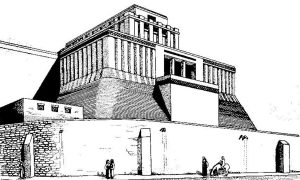
Not all the holy mountains in the history of the world are natural, formed by the shifting of tectonic plates or the sudden, catastrophic opening of “the fountains of the great deep.” The Tower of Babel was one such artificial mountain. Babel was humanity’s attempt to force its way back into the divine council.
At Babel, mankind tried to storm the throne room of God.
For generations, well-meaning Bible teachers have presented the story of Babel as an object lesson on the dangers of pride. Those foolish people were so arrogant they thought they could build a tower high enough to reach heaven!
With all due respect to those teachers, that’s an insult to the intelligence of our ancestors, if you think about it. And it’s a disservice to people in church who want to know why Yahweh was so offended by this project. Really? God is that insecure?
Look, if big egos were enough to bring God to Earth, He’d never leave.
Babel was not a matter of God taking down some people who’d gotten too big for their britches. The clue to the sin of Babel is in the name.
The Hebrew prophets loved to play with language. We often find words in the Bible that sound like the original but make a statement—for example, Beelzebub (“lord of the flies”) instead of Beelzebul (“Ba`al the prince”), or Ish-bosheth (“man of a shameful thing”) instead of Ishbaal (“man of Ba`al”). Likewise, the original Akkadian words bāb ilu, which means “gate of god” or “gate of the gods,” is replaced in the Bible with Babel, which is based on the Hebrew word meaning “confusion.”
Now, there’s a bit of misinformation that must be corrected about the Tower of Babel: Babel was not in Babylon.
It’s an easy mistake to make. The names sound alike, and Babylon is easily the most famous city of the ancient world. It’s also got a bad reputation, especially to Jews and Christians. Babylon, under the megalomaniacal king Nebuchadnezzar, sacked the Temple in Jerusalem and carried off the hardware for temple service. It makes sense to assume that a building project so offensive that God personally intervened must have been built at Babylon.
But there’s a problem with linking Babylon to the Tower of Babel: Babylon didn’t exist when the tower was built. It didn’t even become a city until about a thousand years after the tower incident, and even then it was an unimportant village for about another 500 years.
Traditions and sources outside the Bible identify the builder of the tower as the shadowy figure named Nimrod. Our best guess is he lived sometime between 3500 and 3100 BC, a period of history called the Uruk Expansion. This tracks with what little the Bible tells us about Nimrod. In Genesis 10:10, we read “the beginning of his kingdom was Babel, Erech, Accad, and Calneh, in the land of Shinar.”
The land of Shinar is Sumer and Erech is Uruk. Uruk was so important to human history that Nimrod’s homeland is still called Uruk, five thousand years later! We just spell it differently—Iraq.
Accad was the capital city of the Akkadians, which still hasn’t been found, but was somewhere between Babylon and ancient Assyria. Babylon itself was northwest of Uruk, roughly three hundred miles from the Persian Gulf in what is today central Iraq. But it wasn’t founded until around 2300 BC, at least 700 years after Nimrod, and it wasn’t Babylon as we think about it until the old Babylonian empire emerged in the early part of the 2ndmillennium BC.
So where should we look for the Tower of Babel?
The oldest and largest ziggurat in Mesopotamia was at Eridu, the first city built in Mesopotamia. Scholars put its founding at around 5400 BC. In recent years, scholars have learned that the name Babylon was interchangeable with other city names, including Eridu. So, “Babylon” didn’t always refer to the city of Babylon in ancient texts.
Eridu never dominated the political situation in Sumer after the reigns of its first two kings, Alulim and Alalgar. But as the home city of Enki, god of fresh water, wisdom, and magic, Eridu was so important to Mesopotamian culture that more than three thousand years after Alalgar, Hammurabi the Great was crowned not in Babylon, but in Eridu—even though it had ceased to be a city about three hundred years earlier.
Even as late as the time of Nebuchadnezzar, 1,100 years after Hammurabi, the kings of Babylon still sometimes called themselves LUGAL.NUNki—”King of Eridu.”
Why? What was the deal with Eridu?
Archaeologists have uncovered eighteen levels of the temple to Enki at Eridu. The oldest levels of the E-abzu, a small structure less than ten feet square, date to the founding of the city. And consider that the spot remained sacred to Enki long after the city was deserted around 2000 BC. The temple remained in use until the 5th century BC, nearly five thousand years after the first crude altar was built to accept offerings of fish to Enki, the god of the subterranean aquifer, the abzu.
Now, this is where we tell you that abzu (ab = water + zu = deep) is very likely where we get our English word “abyss.” And the name Enki is a compound word. En is Sumerian for “lord,” and ki is the word for “earth.” Thus, Enki, god of the abzu, was “lord of the earth.”
Do you remember Jesus calling someone “the ruler of this world”? Or Paul referring to “the god of this world”? Who were they talking about?
Yeah. Satan.
Here’s another piece to our puzzle: Nimrod was of the second generation after the flood. His father was Cush, son of Ham, son of Noah. In Sumerian history, the second king of Uruk after the flood was named Enmerkar, son of Mesh-ki-ang-gasher.
Now, get this: An epic poem from about 2000 B.C. called Enmerkar and the Lord of Aratta preserves the basic details of the Tower of Babel story, including the confusion of language among the people of Sumer.
We don’t know exactly where Aratta was, but guesses range from northern Iran to Armenia. That’s intriguing because Armenia is near the center of an ancient kingdom called Urartu, which may be an alternate transliteration of Aratta–and Ararat, where Noah landed his boat. So, it’s possible that Nimrod/Enmerkar tried to intimidate the people (his cousins, basically) who settled near where his great-grandfather landed the ark. Wherever it was, Enmerkar muscled this neighboring kingdom to compel them to send building materials for a couple of projects near and dear to his heart.
Besides building a fabulous temple for Inanna, the goddess of, well, prostitutes, Enmerkar/Nimrod also wanted to expand and upgrade Enki’s abzu—the abyss.
“Let the people of Aratta bring down for me the mountain stones from their mountain, build the great shrine for me, erect the great abode for me, make the great abode, the abode of the gods, famous for me, make my me prosper in Kulaba, make the abzu grow for me like a holy mountain, make Eridug (Eridu) gleam for me like the mountain range, cause the abzu shrine to shine forth for me like the silver in the lode. When in the abzu I utter praise, when I bring the me from Eridug, when, in lordship, I am adorned with the crown like a purified shrine, when I place on my head the holy crown in Unug Kulaba, then may the …… of the great shrine bring me into the jipar, and may the …… of the jipar bring me into the great shrine. May the people marvel admiringly, and may Utu (the sun god) witness it in joy.”1 (Emphasis added)
That’s the issue Yahweh had with it right there. This tower project wasn’t about hubris or pride; it was to build the “abode of the gods” right on top of the abzu.
Could Nimrod have succeeded? Ask yourself: Why did Yahweh find it necessary to personally put a stop to it? A lot of magnificent pagan temples were built in the ancient world, many of them copying the pyramid-like shape of the ziggurats, from Mesopotamia to Mesoamerica. Why did God stop this one?
We can only speculate, of course, but God had a good reason or we wouldn’t have a record of it in the Bible. Calling Babel a sin of pride is easy, but it drains the story of its spiritual and supernatural context.
In the view of this author, the evidence is compelling. It’s time to correct the history we’ve been taught since Sunday School: Babel was not at Babylon, it was at Eridu. The tower was the temple of the god Enki, Lord of the Earth, the god of the abyss. Its purpose was to create an artificial mount of assembly, the abode of the gods, to which humans had access.
That was something that Yahweh could not allow.
1 Black, J.A., Cunningham, G., Fluckiger-Hawker, E, Robson, E., and Zólyomi, G. Enmerkar and the Lord of Aratta, The Electronic Text Corpus of Sumerian Literature (http://etcsl.orinst.ox.ac.uk/cgi-bin/etcsl.cgi?text=t.1.8.2.3#), retrieved 12/17/16.


Thank you Derek,
The information was very interesting. Thank you for all
the research you do to bring us the information. Continue
with the research so I can learn more.
I’m hearing more about A. I. if you get any information about that please let us know.
This article was stunning to me. All my life I have been bewildered by the whole scene at the Tower of Babel. I have heard only a few sermons on this subject in the past 60 years of my life. None of them left me with a sense that I truly understood hardly anything about this amazing event in Biblical history. I am so thankful for this eye opening presentation of so many nuances regarding the Tower of Babel. Thank you for the hours of study you have put into helping us to understand these amazing happenings in the ancient world!! I appreciate this work, along with the books you both write, and the lectures you give. This is a valuable service to the Kingdom of God.
Derek and Sharon Gilbert,
Thank you for all the work you and Sharon do. I learn so much from your studies. Derek Joe Taylor from Crosbyton, Texas passed away March 5 2023. he owned The Mt. Blanco Fossil Museum. The funeral is at 2:00 PM Saturday March 11 at the First Baptist Church in Crosbyton, Texas.
Hi, Michael: Yes, we heard about this from Dr. Aaron Judkins. We didn’t know Joe well, but he was a good man. We really enjoyed getting to know him at Dr. Judd Burton’s “Sons of God, Giants of Old” conferences.
Is there a good resource for a Sumerian time line?